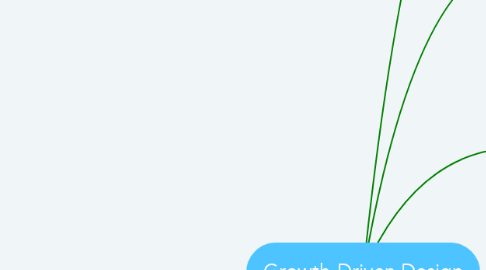
1. Fundamentals
1.1. Strategy-Developing
1.1.1. An empathetic understanding of audience's world and how the website can solve problems of their journey
1.2. Launch Pad
1.2.1. Quickly build a website that perform better than what you have today,but not final product
1.3. Continuous Improvement
1.3.1. Using launch pad site live and collecting user data you can identify high impact actions
2. Developing a Website Strategy
2.1. Core parts
2.1.1. Setting Goals & Forecasts
2.1.1.1. Develop clear understanding of business objective you aim to achieve
2.1.1.2. Goal document
2.1.1.2.1. Mission
2.1.1.2.2. Strategy
2.1.1.2.3. Plays
2.1.1.2.4. KPI (key performance indicators)
2.1.1.2.5. Target
2.1.1.2.6. Stretch
2.1.1.2.7. Actual Y2D
2.1.1.2.8. Omissions
2.1.2. Jobs to be done
2.1.2.1. Customers hiring product or service to help with them complete a certain type of job
2.1.3. Buyer persona
2.1.3.1. Fictional representation of ideal customers
2.1.4. Fundamental assumption
2.1.4.1. Identify riskiest concepts and validate through user research and testing
2.1.5. Journey mapping
2.1.5.1. Development of holistic view of persona's life as they make progress to their job to be done
2.1.6. Website specific strategy
2.1.6.1. Website is specific
2.1.7. Brainstorming a wish list
2.1.7.1. Individual Brainstorming
2.1.7.2. Collective Brainstorming Session
2.1.7.3. Prioritize wish list for Launch Pad
3. Tool Stack
3.1. Investing in GDD Tool Stack
3.1.1. Integration of multiple tools to achieve desired goals which will yield more than using each toll independently
3.2. Building of GDD Tool Stack
3.2.1. Goal
3.2.2. Functionality Consideration
4. Conducting User Research
4.1. User Research
4.1.1. In strategy stage and during the plan step in continuous improvement stage
4.1.2. Perform User Research
4.1.2.1. Write out User questions
4.1.2.2. Choose right research methods
4.1.2.3. Analyse, Report your findings, summarize the key takeaways learning lessons and recommendation
4.1.3. Common Types of Research Methods
4.1.3.1. Qualitative
4.1.3.1.1. Collect direct feedback from user's point of view
4.1.3.2. Observational
4.1.3.2.1. Observing how Users behave in "Wild"
4.1.3.3. Quantitative
4.1.3.3.1. Numerical tracking of actions and behavior
5. Building Launch Pad Website
5.1. Primary Reasons for building Launch pad website
5.1.1. Get out of 'bubble' and start collecting real user data in order to make more informed decisions
5.1.2. Less risky due to lower up front expense and time commitment
5.1.3. Quicker time to value & return on investment
5.1.4. More pleasant process to go through
5.2. Customizing Approach
5.2.1. Launch Pad Acceleration methods
5.2.1.1. Refresh your existing website
5.2.1.2. Kick start using Pre-built assets
5.2.1.3. 80/20 Analysis on Wish list
5.2.1.4. Launch & expand
5.2.1.5. Wise investor
5.3. Implementing Sprint Workshop
5.3.1. Sprint work: A focused period of time where the team steps out of the day to day to collaborate and develop a set of specific deliverable that will be tested on website users
5.4. Developing Effective Content
5.4.1. Quickly creates remarkable content that connects with your users and encourages specific behavior
5.5. Investing in Internal Efficiencies
5.5.1. Find opportunities to remove road blocks, build internal assets and empower the team to take action
6. Implementing Continuous Improvement
6.1. Importance of continuous improvement stage
6.1.1. A repeatable,agile process for the team to continuously collect real user data,build high impact items and generate more and more momentum as they go
6.2. Implementation
6.2.1. Underlying Concepts
6.2.2. Lean Thinking
6.2.3. Agile Process
6.2.4. Continuous improvement cycle consists stages
6.2.4.1. Strategy
6.2.4.2. Quarterly Summit
6.2.4.3. Execution
6.2.4.4. Sprint Cycles
6.3. Running a Sprint Cycle : Plan step
6.3.1. Review current theme,your process and set the sprint cycles focus
6.3.2. Write out job stores
6.3.3. Host planning workshop
6.3.4. Based on capacity ,pull the top items off the wish list for the team to build
6.3.5. Create an action item card for each item
6.4. Running Sprint Cycle: Build Step
6.4.1. Deconstruct each action item
6.4.2. co-ordinate schedules to work together
6.4.3. Host daily stand ups
6.4.4. Outline and setup the experiments
6.5. Running Sprint Cycle: Learn Step
6.5.1. Host a team retrospective
6.5.2. Reflect on both the action items implemented and team performance
6.5.3. Discuss Learning Questions
6.5.4. Finalize User learning and team Kaizen
6.5.5. Document and share your findings
6.6. Running Sprint Cycle: Transfer Step
6.6.1. Host a "Learning,Alignment,Collaboration Meeting" (ACL)
6.6.2. Transparent shared documentation
7. Using Website Optimization Road-Map
7.1. Website Performance Road-map
7.1.1. A framework used by the strategist or the person accountable for the website vision and results during any planning
7.2. Using of Website Performance Road-map
7.2.1. Theme
7.2.1.1. Directional mindset the team should use to think through building & optimizing website
7.2.2. Focus Area
7.2.2.1. A lens through which the team can think about Idealization, Prioritization and building action items
7.2.3. Tactics
7.2.3.1. Specific actions or categories of actions your team can implement to impact the focus metric
7.3. Establish Theme
7.3.1. Improving User Experience and the performance of website for the business
7.3.2. Focus Area
7.3.2.1. Usability
7.3.2.2. CRO (Conversion Rate Optimization)
7.3.2.3. Personalization
7.4. Expand Theme
7.4.1. Think bigger picture and find creative ways to expand the website's impact on users and the company
7.4.2. Focus Area
7.4.2.1. Products
7.4.2.2. User journey
7.4.2.3. The Website
